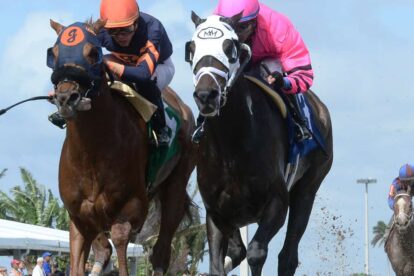Whether you like them or try to beat them, favorites are the key to multi-race sequences.
Every time that I play multi-race bets, the amount I spend and how I construct a ticket is always based off of the strengths of the favorites in the sequence. Specifically, I’m looking for “bad” favorites. Unlike what some may assume, a bad favorite does not mean that the horse is likely to lose, but rather a horse that is going to take exponentially more money than its probability of winning. I would rarely categorize a 3/1 shot as a bad favorite because 3/1 on a favorite in almost any field is reasonable value for the top choice. That doesn’t mean that I’m playing that horse, but beating a 3/1 favorite versus beating a 3/5 favorite has a very different effect on a Pick 5 payout.
Whenever I find that at least 50% of the races in a sequence have bad favorites, I play a big ticket to make sure that I have coverage. In many cases, if I don’t have a strong opinion, I will use the ALL button. There is no feeling worse than when you target a bad 3/5 favorite, just to find out that you don’t have the 20/1 longshot winner on your ticket.
When you beat a horse that is even money or lower, every other horse in that field has much higher multi-race odds compared to its off odds. If you look back at Handicapping 301: Creating Value Around Heavy Favorites, then you can see that on a small scale with double payout. When you are tackling four or five races, then the payout balloons.
What does all of this mean? The most value that you can find is to identify favorites that are more likely to lose due to the circumstances. You would be amazed how much a Pick 5 can pay with five straight second-choice winners simply because 90% of the singles in a sequence will be to a favorite.
So, how to we find a bad favorite?
Running Style
If the short-priced favorite is a DEEP closer (looking at you, Sadler’s Joy), then I rarely single; often, I will go deep to beat it. It’s hard enough to win a horse race, but to do it with factors that are out of your control makes it even more difficult. Ask yourself: is there pace in the race? Is the heavy favorite going to get the trip? Is speed playing well today?
The second question is the biggest problem that I have, especially in larger fields on turf, since that is 100% out of your control. If I do like a closer in a big field, my day will NEVER depend on it. Even though I singled Sadler’s Joy on Travers Day, I made sure to play a backup ticket going four-deep.
Seasonal Debuts
This has been one of the most profitable angles that I have come across. When big names return to the track in seasonal debuts at levels lower than normal, I always play against them. First off, they get hammered at the windows and are even more heavily-singled in multi-race bets. Secondly, more often than not, you end up with small fields because nobody wants to run against the returner, which means that you can use your good friend, the ALL button, and blow up the ticket cost. Finally, rarely does the returner give top effort. These types of races are used as glorified workouts to solidify the horse’s fitness before moving on to the real target.
A great example of this angle is when Mind Your Biscuits returned to the races back in February. He opened his 2018 campaign in an optional claimer, went off at 2/5, and got beat. Notice that he was not ridden all-out or as aggressively as you would expect for a horse in a stretch duel and was only whipped twice:
After the race, trainer Chad Summers said this about Mind Your Biscuits’ loss:
“He wanted to run, he wanted to do something. … I’m not really disappointed at all. There’s bigger fish to fry overseas.”
In case you don’t remember, one month later, he traveled to Dubai and defended his Group 1 Golden Shaheen title.
Need-the-Lead Types
I love looking for lone speed that will help get a longshot home, but it can work against a horse, as well. When you’ve got a heavy favorite that either needs the lead to win or struggles with large amounts of pace pressure, look to see if there is other speed in the race. Often, you will see another horse gun to the lead since they know they cannot win from off the pace. That makes a need-the-lead favorite’s likelihood of winning drop drastically and creates an opportunity for the bettor.
Generally, I lean on this angle in races run at 7 furlongs or more. Sprinting favorites that need the lead are often the fastest horse in the race, so their opponents don’t have the opportunity to force them out of their comfort zone. Keep an eye out for horses going from sprints to routes as under-the-radar pace types. A sprinter that sits third off of a :22.40 opening 1/4-mile in a sprint will often be on the lead if its next start is around two turns.
Small Fields
This seems like it’s out of place, but you’ll often hear “short field, big price” for a reason. When a heavy favorite runs in a small field, all of the other jockeys and trainers often focus on beating that horse specifically, thus making life very difficult for the chalk.
If the favorite wants to stalk, but there isn’t anyone to push the pace, sometimes they are forced to do both, which softens them up for the closers in the late stages of the race. That’s exactly how Cigar’s win streak fell. Siphon was the threat and no one pressed him, so Cigar did it himself, allowing Dare And Go to pick them up and lay them down at 39/1 down the lane:
But if you don’t press, then a maiden can beat you. Just ask the field from the 2016 Jim Dandy Stakes:
Rapid Fire
Class Drop off the Claim – When a horse is claimed and then dropped to a point where the winner’s share of the purse plus the claiming price is LESS then what the new owners paid for the horse one race prior, I bet against. Example – a horse is claimed for $50,000 and runs back in a $20,000 claimer with a $20,000 purse. If it wins and is tagged, then that’s $12,000 for the win and $20,000 for the claim, for a total of $32,000 – an $18,000 loss. Seeing owners risk losing money tells me how little faith they have.
Sprinters going 7 Furlongs – This is not an easy distance. Just because a horse is dominant at 6 furlongs does not mean that it will be able to handle 7. I generally look for milers cutting back a furlong in these races.
First Time Against Winners – Going from facing maidens to facing winners is a larger class hike than most people will take into account. Often, the most over-bet horses are in the N1X (non-winners of one other than) class after winning on debut.
Keep in mind, just because a favorite fits into one of the categories above does not mean that it will lose. It simply may be the best horse. Still, the above list is a good starting point for seeing how many dents are in the armor.










